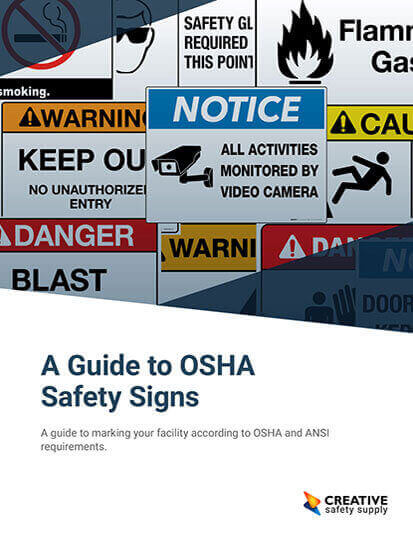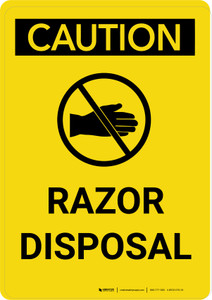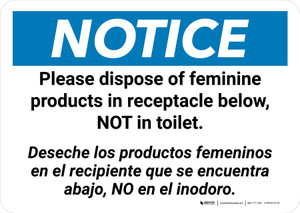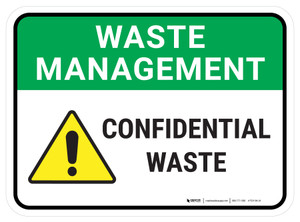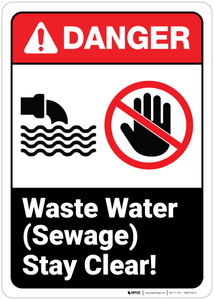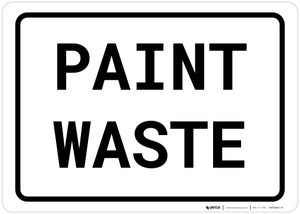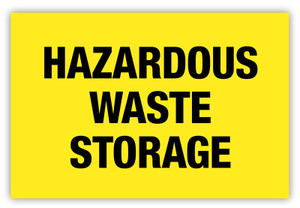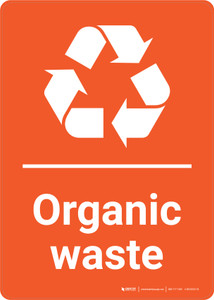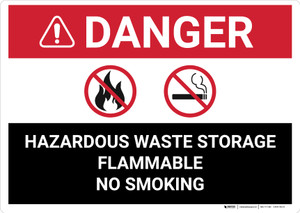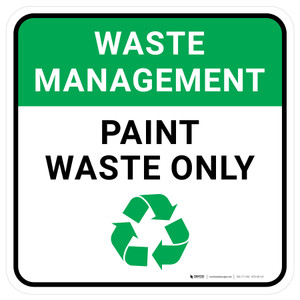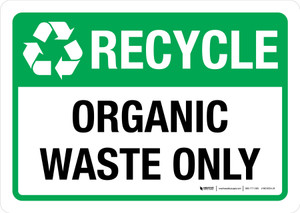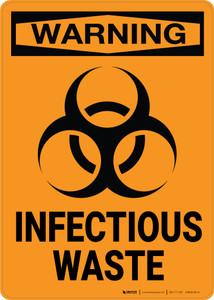-

Here at Creative Safety Supply, we firmly believe that strategically placed visual communication can help any facility prevent workplace injuries, illnesses, and fatalities. Safety signs can be placed in offices, manufacturing plants, warehouses,... More details
-

Printed on industrial-grade vinyl Low-profile material that can withstand pedestrian and forklift traffic No hassle - Peel-&-stick installation More durable than paint This floor sign says, “Hazardous Waste” on it and has a... More details
Hazardous Waste Floor Sign
$18.50 -

Printed on industrial-grade vinyl Low-profile material that can withstand pedestrian and forklift traffic No hassle - Peel-&-stick installation More durable than paint Pictogram Hazardous Waste Floor Sign The pictograms of hazardous waste on this... More details
-

This Hazardous Waste (Red Circle) - Floor Sign features a high contrast and bold design that can be easily seen from a distance, and is constructed using tough, industrial-grade materials, allowing it to survive in the most severe work environment. Our... More details
-

Printed on industrial-grade vinyl Low-profile material that can withstand pedestrian and forklift traffic No hassle - Peel-&-stick installation More durable than paint Having a floor sign that reads, “Caution Hazardous Waste... More details
-

This Hazardous Material Storage Area - Floor Sign features a high contrast and bold design that can be easily seen from a distance, and is constructed using tough, industrial-grade materials, allowing it to survive in the most severe work environment... More details
-

This Caution: Hazardous Waste Satellite Accumulation Point - Wall Sign is constructed using durable, industrial-grade materials, and is designed to be easily noticeable from a distance. Our wall signs such as this one, can be mounted anywhere necessary,... More details
-

This Caution: Razor Disposal with Icon Portrait - Wall Sign is constructed using durable, industrial-grade materials, and is designed to be easily noticeable from a distance. Our wall signs such as this one, can be mounted anywhere necessary, such as... More details
-

This Notice: Please Dispose of Feminine Products in Receptacle Below Landscape - Wall Sign is constructed using durable, industrial-grade materials, and is designed to be easily noticeable from a distance. Our wall signs such as this one, can be mounted... More details
-

This Danger: Hazardous Waste Area - Unauthorized Persons Keep Out Spanish Bilingual Landscape - Wall Sign is constructed using durable, industrial-grade materials, and is designed to be easily noticeable from a distance. Our wall signs such as this one,... More details
-

This Compost Organic Waste Only with Icon Landscape - Wall Sign is constructed using durable, industrial-grade materials, and is designed to be easily noticeable from a distance. Our wall signs such as this one, can be mounted anywhere necessary, such as... More details
-

This Danger: Hazardous Waste Storage - Wall Sign is constructed using durable, industrial-grade materials, and is designed to be easily noticeable from a distance. Our wall signs such as this one, can be mounted anywhere necessary, such as doors, sign... More details
-

This Caution: Hazardous Waste Material Storage Area - Wall Sign is constructed using durable, industrial-grade materials, and is designed to be easily noticeable from a distance. Our wall signs such as this one, can be mounted anywhere necessary, such as... More details
-

Choose from our wide range of options and design a personalized floor sign that stands out and meets your exact needs. Whether you need to warn employees of a specific hazard, or remind them that certain PPE needs to be worn in the area, you can be sure... More details
Custom Hazard Floor Sign
$18.50 -

This Caution: Hazardous Waste Area Labeled Drums - Wall Sign is constructed using durable, industrial-grade materials, and is designed to be easily noticeable from a distance. Our wall signs such as this one, can be mounted anywhere necessary, such as... More details
-

Waste Management: Confidential Waste with Hazard Icon Rectangular - Floor Sign features a high contrast and bold design that can be easily seen from a distance, and is constructed using tough, industrial-grade materials, allowing it to survive in the... More details
-

This Danger: Waste Water Sewage Stay Clear ANSI - Wall Sign is constructed using durable, industrial-grade materials, and is designed to be easily noticeable from a distance. Our wall signs such as this one, can be mounted anywhere necessary, such as... More details
-

This Danger: Hazardous Waste Storage Area Keep Out - Wall Sign is constructed using durable, industrial-grade materials, and is designed to be easily noticeable from a distance. Our wall signs such as this one, can be mounted anywhere necessary, such as... More details
-

This Danger: Hazardous Waste Storage Flammable No Smoking - Wall Sign is constructed using durable, industrial-grade materials, and is designed to be easily noticeable from a distance. Our wall signs such as this one, can be mounted anywhere necessary,... More details
-

This Paint Waste Landscape is constructed using durable, industrial-grade materials, and is designed to be easily noticeable from a distance. Our wall signs such as this one, can be mounted anywhere necessary, such as doors, sign posts, windows and... More details
Paint Waste Landscape
$18.99 -

Label hazardous waste storage locations so proper care is used during operation or transportation. 3 size options available Easy peel-and-stick application Strong adhesive for high durability Chemical, water, and smear resistant Removable without... More details
-

This Organic Waste Orange Portrait - Wall Sign is constructed using durable, industrial-grade materials, and is designed to be easily noticeable from a distance. Our wall signs such as this one, can be mounted anywhere necessary, such as doors, sign... More details
-

This Caution: Hazardous Waste Storage Restricted ANSI - Wall Sign is constructed using durable, industrial-grade materials, and is designed to be easily noticeable from a distance. Our wall signs such as this one, can be mounted anywhere necessary, such... More details
-

This Caution: Hazardous Waste Storage Landscape - Wall Sign is constructed using durable, industrial-grade materials, and is designed to be easily noticeable from a distance. Our wall signs such as this one, can be mounted anywhere necessary, such as... More details
-

This Waste Management: Hazardous waste Landscape - Wall Sign is constructed using durable, industrial-grade materials, and is designed to be easily noticeable from a distance. Our wall signs such as this one, can be mounted anywhere necessary, such as... More details
-

This Danger: Hazardous Waste Keep Out Bilingual Spanish - Wall Sign is constructed using durable, industrial-grade materials, and is designed to be easily noticeable from a distance. Our wall signs such as this one, can be mounted anywhere necessary,... More details
-

This Danger: Hazardous Waste Storage Flammable No Smoking Bilingual with Icon Portrait - Wall Sign is constructed using durable, industrial-grade materials, and is designed to be easily noticeable from a distance. Our wall signs such as this one, can be... More details
-

This Danger: Hazardous Waste Storage Area Unauthorized Persons Keep Out Bilingual Portrait - Wall Sign is constructed using durable, industrial-grade materials, and is designed to be easily noticeable from a distance. Our wall signs such as this one, can... More details
-

This Compost Organic Waste Only with Icon Portrait - Wall Sign is constructed using durable, industrial-grade materials, and is designed to be easily noticeable from a distance. Our wall signs such as this one, can be mounted anywhere necessary, such as... More details
-

This Danger: Hazardous Waste Storage Flammable No Smoking Landscape - Wall Sign is constructed using durable, industrial-grade materials, and is designed to be easily noticeable from a distance. Our wall signs such as this one, can be mounted anywhere... More details
-

Waste Management: Paint Waste Only Square - Floor Sign features a high contrast and bold design that can be easily seen from a distance, and is constructed using tough, industrial-grade materials, allowing it to survive in the most severe work... More details
-

Infectious Waste Biohazard - Floor Marking Sign Upgrade your floor marking program with this Infectious Waste Biohazard - Floor Marking Sign. Improve your plants organization and safety by adding full color visual communication to your floor marking... More details
-

This Caution: Waste Storage Area Vertical with Graphic - Wall Sign is constructed using durable, industrial-grade materials, and is designed to be easily noticeable from a distance. Our wall signs such as this one, can be mounted anywhere necessary, such... More details
-

This Recycle Organic Waste Only Portrait - Wall Sign is constructed using durable, industrial-grade materials, and is designed to be easily noticeable from a distance. Our wall signs such as this one, can be mounted anywhere necessary, such as doors,... More details
-

Caution: Hazardous Waste Material Storage Area - Portrait Wall Sign This A-Frame sign is made from a durable corrugated PVC material with a simple tongue and slot fastening design. Designed as a cost effective mobile sign, these A-Frame's are perfect for... More details
-

This Caution: Hazardous Waste - Wall Sign is constructed using durable, industrial-grade materials, and is designed to be easily noticeable from a distance. Our wall signs such as this one, can be mounted anywhere necessary, such as doors, sign posts,... More details
-

This Warning: Biohazard Infectious Waste - Wall Sign is constructed using durable, industrial-grade materials, and is designed to be easily noticeable from a distance. Our wall signs such as this one, can be mounted anywhere necessary, such as doors,... More details
-

This Danger: Biohazard Infectious Waste - Wall Sign is constructed using durable, industrial-grade materials, and is designed to be easily noticeable from a distance. Our wall signs such as this one, can be mounted anywhere necessary, such as doors, sign... More details
-

This Caution: Hazardous Waste Storage Area Keep Out - Wall Sign is constructed using durable, industrial-grade materials, and is designed to be easily noticeable from a distance. Our wall signs such as this one, can be mounted anywhere necessary, such as... More details
-

This Danger: Hazardous Waste Storage Area Keep Out Landscape with Icon - Wall Sign is constructed using durable, industrial-grade materials, and is designed to be easily noticeable from a distance. Our wall signs such as this one, can be mounted anywhere... More details
Hazardous Waste Signs

Alert workers to
chemical waste areas.
Importance of Using Hazardous Waste Signs
Hazardous waste signs are crucial for ensuring safety and compliance in environments where toxic substances are handled or stored. These signs play a vital role in:
- Preventing accidents and injuries.
- Protecting the environment.
- Communicating risks effectively.
- Ensuring regulatory compliance.
Types and Uses of Hazardous Waste Signs
Hazardous waste signs come in various types, each designed to convey specific information about the hazards present. Here are some common types and their uses:
- Warning signs: These signs alert individuals to potential hazards, such as the presence of toxic substances or flammable materials. They typically feature a yellow background with a black symbol or text.
- Danger signs: Used to indicate immediate hazards that could result in serious injury or death. These signs usually have a red background with a black symbol or text.
- Caution signs: These signs warn of potential hazards that may result in minor or moderate injury. They typically have a yellow background with a black symbol or text, but may also include a black and white design.
- Biohazard signs: These signs are used to indicate the presence of biological materials that may be infectious or harmful. They typically feature a red background with a black biohazard symbol.
- Flammable signs: These signs warn of the presence of flammable materials that can easily ignite or burn. They typically feature a red background with a black flame symbol.
- Corrosive signs: Used to indicate the presence of corrosive substances that can cause skin burns or damage to materials. They typically feature a black background with a white skull and crossbones symbol.
- Oxidizing agent signs: These signs warn of the presence of oxidizing agents that can support combustion or intensify a fire. They typically feature a red background with a black flame symbol and the word "OXIDIZER."
Hazardous waste signage is used in a variety of settings, including:
- Industrial facilities: Factories, manufacturing plants, and other industrial facilities often use hazardous waste signs to warn employees and visitors of the presence of dangerous materials.
- Laboratories: Research laboratories and other scientific facilities may use hazardous waste signs to indicate the presence of hazardous chemicals or biological materials.
- Waste disposal sites: Landfills, incinerators, and other waste disposal facilities may use hazardous waste signs to warn of the presence of toxic or hazardous waste.
- Construction sites: Construction sites may use hazardous waste signs to indicate the presence of hazardous materials, such as asbestos or lead.
- Transportation facilities: Shipping containers, trucks, and other transportation vehicles may use hazardous waste signs to indicate the presence of dangerous materials being transported.
Custom Hazardous Waste Signs
In addition to standard hazardous waste signs, we can also create custom signs tailored to your specific needs. Our team can design and manufacture signs that meet your exact specifications.
FAQ:
What are hazardous waste symbols?
Hazardous waste symbols are standardized pictograms used on signs to quickly and easily convey the specific hazards associated with a particular substance. These symbols are typically used in conjunction with warning or danger signs to provide clear and concise information about the potential risks.
How do you know if a waste is hazardous?
Determining whether a waste is hazardous can be complex and often requires specialized knowledge. However, there are several factors to consider, including:
- Toxicity: Does the waste contain substances that are harmful to human health or the environment?
- Ignitability: Is the waste flammable or capable of supporting combustion?
- Reactivity: Does the waste react with other substances to produce dangerous conditions, such as heat, gas, or a fire?
- Corrosivity: Can the waste cause skin burns or damage to materials?
- Biological infectious agents: Does the waste contain harmful biological materials, such as bacteria or viruses?
If you are unsure whether a waste is hazardous, it is always best to consult with a qualified professional or refer to relevant regulations and guidelines.
How do you identify hazardous and non-hazardous waste?
There are several methods for identifying hazardous and non-hazardous waste, including:
- Examine the waste for any signs of hazardous materials, such as warning labels, corrosive substances, or flammable liquids.
- Consult the MSDS for any chemicals or materials present in the waste to determine their hazardous properties.
- Refer to relevant regulations and guidelines to identify hazardous waste characteristics and disposal requirements.
- In some cases, laboratory testing may be necessary to determine the hazardous properties of a waste.
What must hazardous waste labels include?
Hazardous waste labels must contain specific information to ensure proper handling, storage, and disposal. This information typically includes:
- The word "HAZARDOUS WASTE" in a prominent location
- The name of the hazardous substance
- The hazard warning symbol
- A brief description of the potential hazards
- The name and address of the generator
- The date of generation
- The EPA waste code
Free OSHA Safety Signs E-Book
Understand OSHA sign classifications and ensure proper placement in your facility.
Helpful Resources
